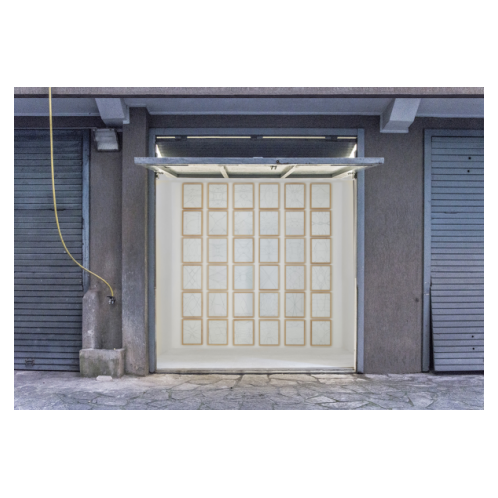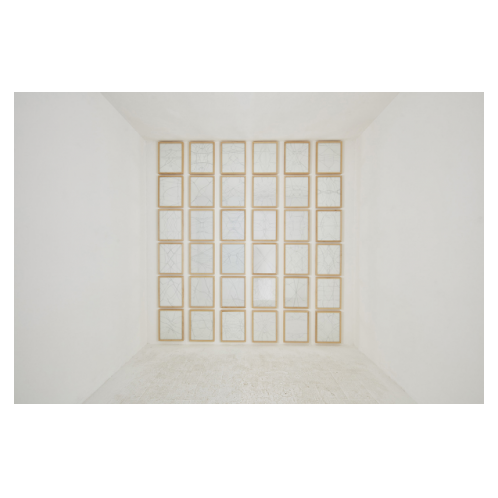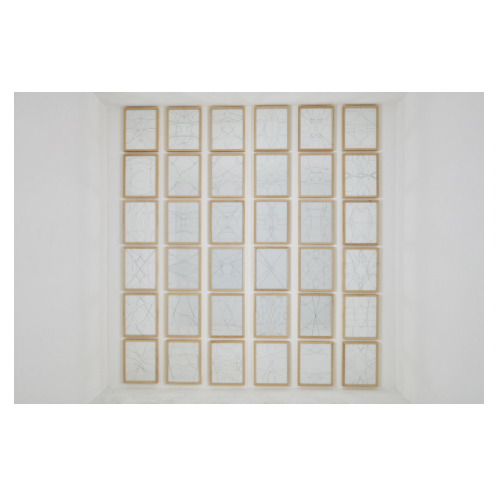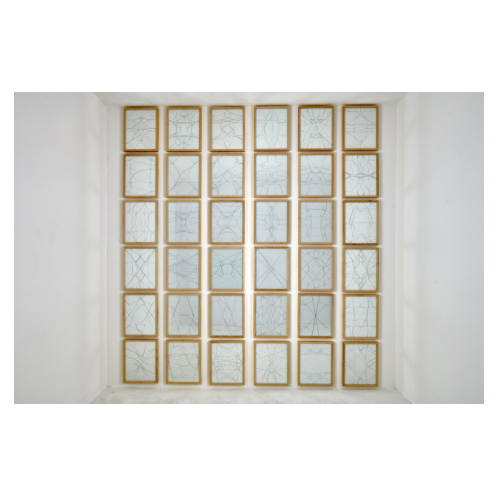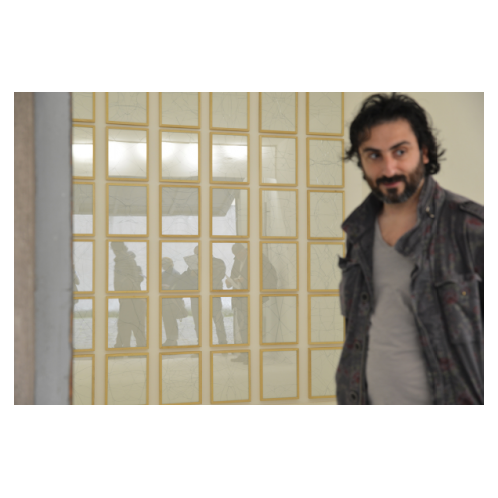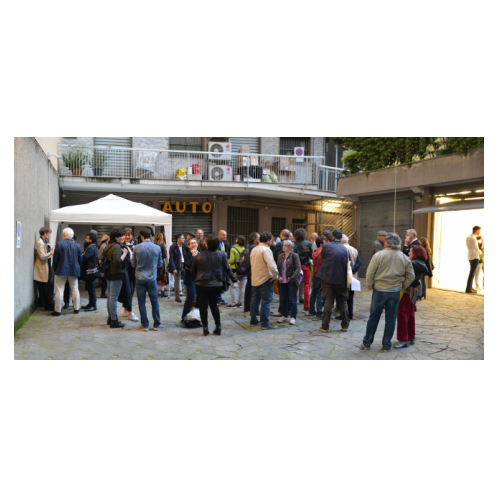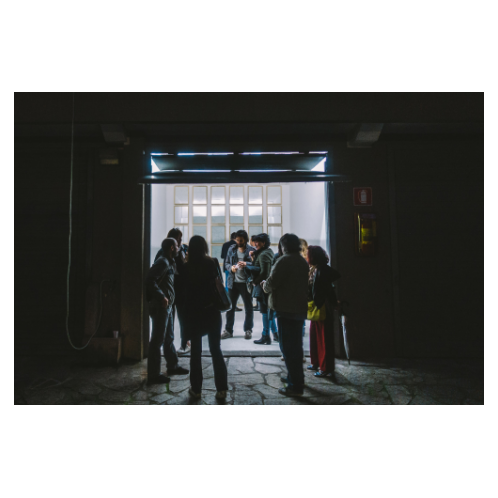ANDREA FRANCOLINO
CASO × CAOS × INFINITE VARIABILI
a cura di
GIORGIO FASOL
INAUGURAZIONE
GIOVEDI 17 MAGGIO 2018
ore 18-21
dal 17 maggio al 30 agosto 2018
solo su appuntamento
Andrea Francolino: Ecco il lavoro allestito nella sua versione finale così come sarà presentato a The Open Box; come sai è intitolato Caso × caos × infinite variabili e per me è una vera e propria teoria raggiunta. Horace Walpole ha parlato di “serendipità” (serendipity) ovvero la capacità o la fortuna di fare per caso inattese e felici scoperte. Il 12 aprile 2017, girovagando per Milano, mi imbatto in un quadro con vetro rotto abbandonato di fianco a un bidone di rifiuti. Successivamente rivivo un evento simile in un centro commerciale dove noto che una cornice che mi interessava acquistare aveva un vetro rotto; ho comprato questi frammenti – con sincera perplessità del personale del negozio – per cambiare il destino di questi vetri. Era un’ulteriore occasione per riflettere su temi a me cari: fragilità, caso e caos, la dialettica tra Uomo e Natura e altro ancora… Giorgio Fasol: Sono anni che seguo il tuo lavoro. Una delle tue opere che mi ha colpito e commosso subito è stata Performance di una pianta (2013-2015), oggi nella mia collezione. Vedere quel fiore che sboccia dai frammenti di cemento è stato un vero “colpo di fulmine”, geniale! E per me deve scattare una “scintilla”; l’artista poi deve essere bravo in tre parole a dare le linee guida del lavoro, è necessaria la capacità di sintesi. Ora con questo nuovo lavoro vedo un’ulteriore riflessione su questo tuo cammino. Ci sono motivi che si ripresentano, è chiaro il filo conduttore, ci sono le crepe, il caos che genera qualcosa di armonico, di positivo e questo è un ulteriore passo in avanti… Comprare un’opera è un atto di amore, io devo innamorarmi a prima vista di un lavoro, poi si passa all’approfondimento critico, biografico, culturale… Andrea Francolino: Questa tua scintilla sembra la stessa che mi scatta e che in seguito genera il lavoro, cioè per me quello che tu hai definito “colpo di fulmine” quando vedi un’opera succede quando vedo le crepe sul manto stradale, le macerie di edifici abbandonati o i frammenti di vetri rotti per le strade… E anche se i miei primi tentativi sono sempre fallimentari, so che poi pian piano scopro la soluzione e quella migliore è sempre la più semplice. Magari tante persone hanno visto quei frammenti di vetro, ma in me hanno fatto scattare un “qualcosa” che mi ha portato a ragionare sui frammenti stessi e poi pian piano sul lavoro finale in corso d’opera raggiungendo il senso di quella cosa. Giorgio Fasol: Questa riflessione è vicina al “momento rivelativo” di cui parlava Giorgio de Chirico… Non so se è un caso, ma come ho già raccontato altre volte, ho iniziato il mio percorso nell’arte guardando un dipinto di Giorgio Morandi; non so ancora capire “il perché”, ma la sua semplicità e la sua poesia mi hanno subito colpito… Ero giovanissimo e non sapevo nulla di Metafisica o su quale fosse il contributo di Morandi alla storia dell’arte. È stato proprio un momento rivelativo… Andrea Francolino: In effetti anche la genesi di Performance di una pianta ha seguito un percorso simile… Avevo questi scarti di cemento di altri miei lavori accatastati fuori dallo studio da un po’ di tempo quando un giorno ho notato che da quelle macerie era nata (o rinata) la vita, un’esile piantina spontanea. Appoggio la teoria che anche l’universo sia nato in questo modo, cioè da una semplice “scintilla”, un urto che genera il tutto continuando il suo percorso. Sin dall’antichità artisti o filosofi hanno elaborato le proprie teorie guardando il cielo, l’universo… potrà sembrare assurdo ma anche per me c’è un procedimento simile, guardare una crepa è come guardare l’universo, mi interrogo sul senso della vita e sul senso delle cose. Da questo sguardo nascono le mie riflessioni e i miei lavori… Ora che Caso × caos × infinite variabili è terminato nella sua prima versione in 36 elementi credo di vederci proprio l’universo; ogni singolo riquadro lo associo a una costellazione o a una galassia e queste sono solo alcune delle sue variabili infinite. Ho cercato di riprodurre manualmente su altri vetri le crepe formatesi in modo totalmente casuale e caotico sui vetri rotti, abbandonati. E, andando per opposti, assoluti, il risultato è un’armonia o simmetria incredibile; quanto tempo ci è voluto per giungere a questa semplicità e quanto lavoro dietro ognuna di esse! La soluzione del vetro rotto era nel vetro rotto. Giorgio Fasol: Nel 1970 in una galleria qui di Milano, nell’ufficio del gallerista, sono stato rapito da un lavoro “accatastato” o “impilato” tra tanti altri; era un’opera di Cy Twombly, anche in quel caso, pur essendo molto diverso da Morandi, questa semplicità apparente mi ha conquistato, le linee caotiche – ma che avevano la loro armonia – sembravano le galassie o l’universo di cui stai parlando tu… Forse l’unico mio esercizio è quello di aver guardato e continuare a guardare molte opere, la memoria visiva è importantissima… Ma a parte questo ci sono modalità inspiegabili. Pensa a M’illumino d’immenso; Ungaretti, la straordinarietà dei suoi versi come è inspiegabile, semplicissimo, brevissimo ma con una forza poetica meravigliosa. Mi ha colpito la tua riflessione su Walpole, quindi un letterato, un “poeta”… Andrea Francolino: Anche Walpole è stata una scoperta “casuale” e poi ho scoperto che proprio lui ha parlato della serendipità di cui parlavamo prima. Forse avevo già un mio bagaglio culturale o forse una predisposizione per questo tipo di nuovi lavori, ma è stato intrigante scoprire “per caso” uno scrittore che parla “del caso” lì dove vagavo piacevolmente tra tante discipline e teorie. Giorgio Fasol: Probabilmente è anche una questione legata al tuo o al nostro inconscio. A volte bisogna liberare l’inconscio per avere alcune rivelazioni, poi magari rielaborate o razionalizzate per ultimare il lavoro artistico o anche per decidere quale opera acquistare. Scintilla, inconscio ma la conoscenza alla base. Ecco, ti parlo anche di questo aneddoto: alla fine della Seconda Guerra Mondiale avevo sette o otto anni e girovagavo tra le macerie con un martello per togliere i calcinacci dai mattoni per poi rivendere i mattoni stessi a imprenditori e costruttori che li usavano per costruire qualcosa di nuovo. Ecco forse, ripensandoci ora, forse apprezzo anche “inconsciamente” i tuoi lavori perché mi riportano alla mente ricordi che sto valutando soltanto ora e che sono positivi, e il tuo lavoro è positivo. Andrea Francolino: Chissà forse lo stupendo panorama dei “sassi” di Matera e i suoi frammenti con cui sono cresciuto… anche questo ha condizionato le mie scelte artistiche. Rifletto con positività sui frammenti che mi circondano.
(Estratto da una conversazione avvenuta nello studio dell’artista a Milano il 5 maggio 2018)
Didascalia: Caso × caos × infinite variabili, 2017-2018, vetri, cornici in legno con vetro, 36 elementi, ciascuno composto da un vetro rotto casualmente e tre vetri intagliati a mano disposti in quattro versi differenti, 47,9 × 37,8 cm; misure complessive 300 × 230 cm circa.
THE OPEN BOX
Via G.B. Pergolesi 6
20124
info.theopenbox.org@gmail.com
ANDREA FRANCOLINO
CHANCE × CHAOS × INFINITE VARIABLES
curated by
GIORGIO FASOL
OPENING
THURSDAY 17 MAY 2018
6-9 pm
from 17 May to 30 August 2018 by appointment only
Andrea Francolino: Here’s the work in its final form as it’ll be presented at The Open Box; as you know, it’s entitled Caso × caos × infinite variabili [Chance × chaos × infinite variables] and for me it’s the proof of a theory. Horace Walpole spoke of “serendipity”, that is the capacity or the good fortune to make unexpected and felicitous discoveries. On the 12th of April 2017, wandering round Milan, I came across a picture abandoned alongside a rubbish bin, with the glass in the frame broken. I later relived a similar event in a shopping centre where I noticed that the glass in a frame I was thinking of buying was broken; I bought the fragments – to the sincere perplexity of the shop staff – in order to change the destiny of the glass. It was another chance to reflect on themes that are dear to me: fragility, chance and chaos, the dialectic between Man and Nature and so on… Giorgio Fasol: I’ve been following your work for years. One of your pieces that immediately struck and moved me was Performance di una pianta (2013-2015), now in my collection. Seeing that flower emerging from the fragments of concrete it was truly “love at first sight”, brilliant! For me there has to be a “spark”; the artist then has to good at presenting the principles of their work in a few words, you need that capacity for synthesis. Now, with this new work I can see a further reflection on your path. There are recurring motifs, the fil rouge is clear, there are the cracks, the chaos that generates something harmonious, something positive and this is further progress… Acquiring a work of art is an act of love, I have to fall in love with a work at first sight, then you move on to a critical, biographical, cultural appraisal… Andrea Francolino: This spark of yours seems to be the same one I experience and that subsequently generates the work; that is, for me what you have defined as “love at first sight” when you come across a work happens when I see the cracks in the road surface, the rubble from abandoned buildings or the fragments of broken glass on the streets... And even though my first attempts are always failures, I know that I’ll slowly find the solution and that the best is always the simplest. Loads of people have perhaps seen those bits of glass, but they “something” off in me that led me to think about the fragments themselves and then gradually about the final piece in progress, reaching the sense of the thing. Giorgio Fasol: This reflection is close to the “revelatory moment” Giorgio de Chirico spoke about… I don’t know if it’s a coincidence, but as I’ve said before, I began my exploration of art by looking at a painting by Giorgio Morandi; I still can’t explain “the why”, but its simplicity and its poetry struck me immediately… I was really young and knew nothing about Metaphysics or Morandi’s contribution to the history of art. It was a truly revelatory moment… Andrea Francolino: In effect, the genesis of Performance di una pianta followed a similar path… I’d had these remains of cement from other works stored outside the studio for some time when one day I noticed that out of that rubble had been born (or reborn) a life, a tiny spontaneous plant. I support the theory whereby the universe was born in the same way; that is, from a simple “spark”, a collision that generates everything as it continues on its path. Since antiquity, artists or philosophers have developed theories looking to the sky, to the universe... It might seem absurd but there’s a process that’s similar for me too, looking at a crack is like looking at the universe, I ask myself about the meaning of life and the meaning of things. Out of this gaze are born my reflections and my works… Now that the first version in 36 elements of Caso × caos × infinite variabili is finished I really believe I can see the universe in it; in every single panel with a constellation or a galaxy and these are just a few of its infinite variables. I’ve tried to reproduce manually on other bits of glass the cracks that form totally casually and chaotically on broken, abandoned glass. By the law of opposites, the result is an incredible harmony or symmetry; the time it took to reach this simplicity and how much work behind each of them! The solution for the broken glass lay in the broken glass. Giorgio Fasol: In 1970, in a gallery here in Milan, in the office of the gallerist, I was transfixed by a work “stacked” or “piled” amidst numerous others; it was a piece by Cy Twombly, and in this case too, while very different to Morandi, this apparent simplicity won me over, the chaotic lines – but which had their own harmony – seemed to be galaxies or the universe you’re talking about… Perhaps all I have done is to have looked and to continue to look at many works; visual memory is so important… But apart from this there are inexplicable processes. Think of M’illumino d’immenso; Ungaretti, how the extraordinary nature of his verses is inexplicable, incredibly simply, so brief but with such a marvellous poetic strength. I was struck by your comment about Walpole, a writer, a “poet”... Andrea Francolino: Walpole was also a “casual” discovery and then I found out that he had actually spoke about the serendipity we were talking about before. Perhaps I already had my cultural baggage or perhaps a predisposition for this new kind of work, but it was intriguing to discover “by chance” a writer talking about “chance” right where I was happily wandering amidst diverse disciplines and theories. Giorgio Fasol: It’s probably also a question associated with your or our subconscious. At times we need to free the subconscious to have certain revelations, perhaps later reworked or rationalized to complete an artistic work or even to decide which piece to acquire. Spark, subconscious, but knowledge underlying it all. Listen I’ll tell you this story too: at the end of the Second World War I was seven or eight years old and was roaming the ruins with a hammer to knock off the mortar from bricks which I would then sell to the dealers and builders who used them to build something new. Thinking about it now, perhaps I also appreciate your works “subconsciously” because they bring back memories that only now am I reconsidering and that they’re positive, and your work’s positive. Andrea Francolino: Who knows, perhaps the stupendous panorama of the “sassi” at Matera and its fragments with which I grew up also condition my artistic choices. I reflect positively on the fragments that surround me.
(Extract from a conversation in the artist’s studio in Milan on 5 May 2018)
Captions: Caso × caos × infinite variabili / Chance × chaos × infinite variables, 2017-2018, glass, wooden frames with glass, 36 elements, each composed of a casually broken piece of glass and three pieces of glass engraved by hand arranged in four different ways, 47,9 × 37,8 cm; overall dimensions around 300 × 230 cm.
THE OPEN BOX
non profit space for art
Via G.B. Pergolesi 6
20124
MILANO
www.theopenbox.org
info.theopenbox.org@gmail.com
+393382632596

